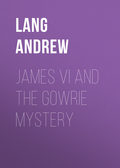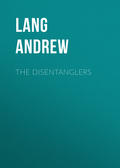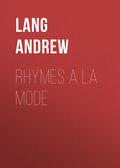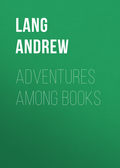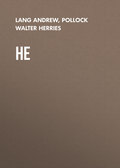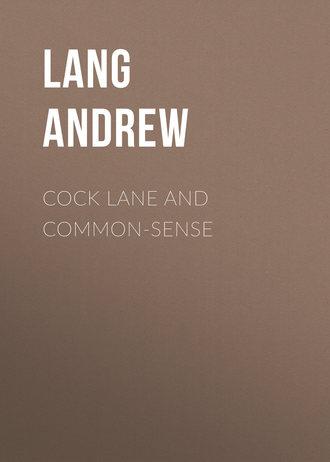
Lang Andrew
Cock Lane and Common-Sense
TO JAMES PAYN, Esq
Dear Payn,
Spirits much more rare and valuable than those spoken of in this book are yours. Whatever ‘Mediums’ may be able to do, you can ‘transfer’ High Spirits to your readers; one of whom does not hope to convert you, and will be fortunate enough if, by this work, he can occasionally bring a smile to the lips of his favourite novelist.
With more affection and admiration than can be publicly expressed,
Believe me,
Yours ever,
ANDREW LANG.
PREFACE
Since the first publication of Cock Lane and Common-Sense in 1894, nothing has occurred to alter greatly the author’s opinions. He has tried to make the Folklore Society see that such things as modern reports of wraiths, ghosts, ‘fire-walking,’ ‘corpse-lights,’ ‘crystal-gazing,’ and so on, are within their province, and within the province of anthropology. In this attempt he has not quite succeeded. As he understands the situation, folklorists and anthropologists will hear gladly about wraiths, ghosts, corpse-candles, hauntings, crystal-gazing, and walking unharmed through fire, as long as these things are part of vague rural tradition, or of savage belief. But, as soon as there is first-hand evidence of honourable men and women for the apparent existence of any of the phenomena enumerated, then Folklore officially refuses to have anything to do with the subject. Folklore will register and compare vague savage or popular beliefs; but when educated living persons vouch for phenomena which (if truly stated) account in part for the origin of these popular or savage beliefs, then Folklore turns a deaf ear. The logic of this attitude does not commend itself to the author of Cock Lane and Common-Sense.
On the other side, the Society for Psychical Research, while anxiously examining all the modern instances which Folklore rejects, has hitherto neglected, on the whole, that evidence from history, tradition, savage superstition, saintly legend, and so forth, which Folklore deigns to regard with interest. The neglect is not universal, and the historical aspect of these beliefs has been dealt with by Mr. Gurney (on Witchcraft), by Mr. Myers (on the Classical Oracles), and by Miss X. (on Crystal-Gazing). Still, the savage and traditional evidence is nearly as much eschewed by psychical research, as the living and contemporary evidence is by Folklore. The truth is that anthropology and Folklore have a ready-made theory as to the savage and illusory origin of all belief in the spiritual, from ghosts to God. The reported occurrence, therefore, of phenomena which suggest the possible existence of causes of belief not accepted by anthropology, is a distasteful thing, and is avoided. On the other hand, psychical research averts its gaze, as a rule, from tradition, because the testimony of tradition is not ‘evidential,’ not at first hand.
In Cock Lane and Common-Sense an attempt is made to reconcile these rather hostile sisters in science. Anthropology ought to think humani nihil a se alienum. Now the abnormal and more or less inexplicable experiences vouched for by countless living persons of honour and sanity, are, at all events, human. As they usually coincide in character with the testimony of the lower races all over the world; with historical evidence from the past, and with rural Folklore now and always, it really seems hard to understand how anthropology can turn her back on this large human province. For example, the famous affair of the disturbances at Mr. Samuel Wesley’s parsonage at Epworth, in 1716, is reported on evidence undeniably honest, and absolutely contemporary. Dr. Salmon, the learned and acute Provost of Trinity College, Dublin, has twice tried to explain the phenomena as the results of deliberate imposture by Hetty Wesley, alone, and unaided. 1 The present writer examined Dr. Salmon’s arguments (in the Contemporary Review, August, 1895), and was able, he thinks, to demonstrate that scarcely one of them was based on an accurate reading of the evidence. The writer later came across the diary of Mr. Proctor of Wellington, near Newcastle (about 1840), and found to his surprise that Mr. Proctor registered on occasion, day by day, for many years, precisely the same phenomena as those which had vexed the Wesleys. 2 Various contradictory and mutually exclusive theories of these affairs have been advanced. Not one hypothesis satisfies the friends of the others: not one bears examination. The present writer has no theory, except the theory that these experiences (or these modern myths, if any one pleases), are part of the province of anthropology and Folklore.
He would add one obvious yet neglected truth. If a ‘ghost-story’ be found to contain some slight discrepancy between the narratives of two witnesses, it is at once rejected, both by science and common-sense, as obviously and necessarily and essentially false. Yet no story of the most normal incident in daily life, can well be told without some discrepancies in the relations of witnesses. None the less such stories are accepted even by juries and judges. We cannot expect human testimony suddenly to become impeccable and infallible in all details, just because a ‘ghost’ is concerned. Nor is it logical to demand here a degree of congruity in testimony, which daily experience of human evidence proves to be impossible, even in ordinary matters.
A collection of recent reports of ‘fire-walking’ by unscorched ministrants, in the South Seas, in Sarawak, in Bulgaria, and among the Klings, appeals to the present writer in a similar way. Anthropology, he thinks, should compare these reports of living witnesses, with the older reports of similar phenomena, in Virgil, in many books of travel, in saintly legends, in trials by ordeal, and in Iamblichus. 3 Anthropology has treasured the accounts of trials by the ordeal of fire, and has not neglected the tales of old travellers, such as Pallas, and Gmelin. Why she should stand aloof from analogous descriptions by Mr. Basil Thomson, and other living witnesses, the present writer is unable to imagine. The better, the more closely contemporary the evidence, the more a witness of the abnormal is ready to submit to cross-examination, the more his testimony is apt to be neglected by Folklorists. Of course, the writer is not maintaining that there is anything ‘psychical’ in fire-walking, or in fire-handling. Put it down as a trick. Then as a trick it is so old, so world-wide, that we should ascertain the modus of it. Mr. Clodd, following Sir B. W. Richardson, suggests the use of diluted sulphuric acid, or of alum. But I am not aware that he has tried the experiment on his own person, nor has he produced an example in which it was successfully tried. Science demands actual experiment.
The very same remarks apply to ‘Crystal-Gazing’. Folklore welcomes it in legend or in classical or savage divination. When it is asserted that a percentage of living and educated and honourable people are actually hallucinated by gazing into crystals, the President of the Folklore Society (Mr. Clodd) has attributed the fact to a deranged liver. 4 This is a theory like another, and, like another, can be tested. But, if it holds water, then we have discovered the origin of the world-wide practice of crystal-gazing. It arises from an equally world-wide form of hepatic malady.
In answer to all that has been urged here, anthropologists are wont to ejaculate that blessed word ‘Survival’. Our savage, and mediæval, and Puritan ancestors were ignorant and superstitious; and we, or some of us, inherit their beliefs, as we may inherit their complexions. They have bequeathed to us a tendency to see the viewless things, and hear the airy tongues which they saw and heard; and they have left us the legacy of their animistic or spiritualistic explanation of these subjective experiences.
Well, be it so; what does anthropology study with so much zest as survivals? When, then, we find plenty of sane and honest people ready with tales of their own ‘abnormal’ experiences, anthropologists ought to feel fortunate. Here, in the persons of witnesses, say, to ‘death-bed wraiths,’ are ‘survivals’ of the liveliest and most interesting kind. Here are parsons, solicitors, soldiers, actors, men of letters, peers, honourable women not a few, all (as far as wraiths go), in exactly the mental condition of a Maori. Anthropology then will seek out these witnesses, these contemporary survivals, these examples of the truth of its own hypothesis, and listen to them as lovingly as it listens to a garrulous old village wife, or to an untutored Mincopi.
This is what we expect; but anthropology, never glancing at our ‘survivals,’ never interrogating them, goes to the Aquarium to study a friendly Zulu. The consistency of this method laisse a désirer! One says to anthropologists: ‘If all educated men who have had, or believe they have had “psychical experiences” are mere “survivals,” why don’t you friends of “survivals” examine them and cross examine them? Their psychology ought to be a most interesting proof of the correctness of your theory. But, far from studying the cases of these gentlemen, some of you actually denounce, for doing so, the Society for Psychical Research.’
The real explanation of these singular scientific inconsistencies is probably this. Many men of science have, consciously or unconsciously, adopted the belief that the whole subject of the ‘abnormal,’ or, let us say, the ‘psychical,’ is closed. Every phenomenon admits of an already ascertained physical explanation. Therefore, when a man (however apparently free from superstitious prejudice) investigates a reported abnormal phenomenon, he is instantly accused of wanting to believe in a ‘supernatural explanation’. Wanting (ex hypothesi) to believe, he is unfit to investigate, all his conclusions will be affirmative, and all will be worthless.
This scientific argument is exactly the old argument of the pulpit against the atheist who ‘does not believe because he does not want to believe’. The writer is only too well aware that even scientific minds, when bent on these topics, are apt to lose balance and sanity. But this tendency, like any other mental bad habit, is to be overcome, and may be vanquished.
Manifestly it is as fair for a psychical researcher to say to Mr. Clodd, ‘You won’t examine my haunted house because you are afraid of being obliged to believe in spirits,’ as it is fair for Mr. Clodd to say to a psychical researcher, ‘You only examine a haunted house because you want to believe in spirits; and, therefore, if you do see a spook, it does not count’.
We have recently seen an instructive example. Many continental savants, some of them bred in the straitest sect of materialists, examined, and were puzzled by an Italian female ‘medium’. Effects apparently abnormal were attested. In the autumn of 1895 this woman was brought to England by the Society for Psychical Research. They, of course, as they, ex hypothesi, ‘wish to believe,’ should, ex hypothesi, have gone on believing. But, in fact, they detected the medium in the act of cheating, and publicly denounced her as an impostor. The argument, therefore, that investigation implies credulity, and that credulity implies inevitable and final deception, scarcely holds water.
One or two slight corrections may be offered here. The author understands that Mr. Howitt does not regard the Australian conjurers described on p. 41, as being actually bound by the bark cords ‘wound about their heads, bodies, and limbs’. Of course, Mr. Howitt’s is the best evidence possible.
To the cases of savage table-turning (p. 49), add Dr. Codrington’s curious examples in The Melanesians, p. 223 (Oxford, Clarendon Press, 1891).
To stories of fire-handling, or of walking-uninjured through fire (p. 49), add examples in The Journal of the Polynesian Society, vol. ii., No. 2, June, 1893, pp. 105-108. See also ‘At the Sign of the Ship,’ Longman’s Magazine, August, 1894, and The Quarterly Review, August, 1895, article on ‘The Evil Eye’.
Mr. J. W. Maskelyne, the eminent expert in conjuring, has remarked to the author that the old historical reports of ‘physical phenomena,’ such as those which were said to accompany D. D. Home, do not impress him at all. For, as Mr. Maskelyne justly remarks, their antiquity and world-wide diffusion (see essays on ‘Comparative Psychical Research,’ and on ‘Savage and Classical Spiritualism’) may be accounted for with ease. Like other myths, equally uniform and widely diffused, they represent the natural play of human fancy. Inanimate objects are stationary, therefore let us say that they move about. Men do not float in the air. Let us say that they do. Then we have the ‘physical phenomena’ of spiritualism. This objection had already occurred to, and been stated by, the author. But the difficulty of accounting for the large body of respectable evidence as to the real occurrence of the alleged phenomena remains. Consequently the author has little doubt that there is a genuine substratum of fact, probably fact of conjuring, and of more or less hallucinatory experience. If so, the great antiquity and uniformity of the tricks, make them proper subjects of anthropological inquiry, like other matters of human tradition. Where conditions of darkness and so on are imposed, he does not think that it is worth while to waste time in examination.
Finally, the author has often been asked: ‘But what do you believe yourself?’
He believes that all these matters are legitimate subjects of anthropological inquiry.
London, 27th October, 1895.
INTRODUCTION
Nature of the subject. Persistent survival of certain Animistic beliefs. Examples of the Lady Onkhari, Lucian, General Campbell. The Anthropological aspect of the study. Difference between this Animistic belief, and other widely diffused ideas and institutions. Scientific admission of certain phenomena, and rejection of others. Connection between the rejected and accepted phenomena. The attitude of Science. Difficulties of investigation illustrated. Dr. Carpenter’s Theory of unconscious Cerebration. Illustration of this Theory. The Failure of the Inquiry by the Dialectical Society. Professor Huxley, Mr. G. H. Lewes. Absurdity and charlatanism of ‘Spiritualism’. Historical aspect of the subject. Universality of Animistic Beliefs, in every stage of culture. Not peculiar to savagery, ignorance, the Dark Ages, or periods of Religious crisis. Nature of the Evidence.
It is not without hesitation that this book is offered to the reader. Very many people, for very various reasons, would taboo the subjects here discoursed of altogether. These subjects are a certain set of ancient beliefs, for example the belief in clairvoyance, in ‘hauntings,’ in events transcending ordinary natural laws. The peculiarity of these beliefs is, that they have survived the wreck of faith in such elements of witchcraft as metamorphosis, and power to cause tempest or drought. To study such themes is ‘impious,’ or ‘superstitious,’ or ‘useless’. Yet to a pathologist, or anthropologist, the survivals of beliefs must always be curious and attractive illustrations of human nature.
Ages, empires, civilisations pass, and leave some members even of educated mankind still, in certain points, on the level of the savage who propitiates with gifts, or addresses with prayers, the spirits of the dead.
An example of this endurance, this secular survival of belief, may be more instructive and is certainly more entertaining than a world of assertions. In his Études Égyptiennes (Tome i. fascic. 2) M. Maspero publishes the text and translation of a papyrus fragment. This papyrus was discovered still attached to a statuette in wood, representing ‘the singer of Ammen, Kena,’ in ceremonial dress. The document is a letter written by an ancient Egyptian scribe, ‘To the Instructed Khou of the Dame Onkhari,’ his own dead wife, the Khou, or Khu, being the spirit of that lady. The scribe has been ‘haunted’ since her decease, his home has been disturbed, he asks Onkhari what he has done to deserve such treatment: ‘What wrong have I been guilty of that I should be in this state of trouble? what have I done that thou should’st help to assail me? no crime has been wrought against thee. From the hour of my marriage till this day, what have I wrought against thee that I need conceal?’
He vows that, when they meet at the tribunal of Osiris, he will have right on his side.
This letter to the dead is deposited in the tomb of the dead, and we may trust that the scribe was no longer annoyed by a Khou, which being instructed, should have known better. To take another ancient instance, in his Philopseudes Lucian introduces a kind of club of superstitious men, telling ghost stories. One of them assures his friend that the spectre of his late wife has visited and vexed him, because he had accidentally neglected to burn one of a pair of gilt shoes, to which she was attached. She indicated the place where the shoe was lying hidden, and she was pacified. Lucian, of course, treats this narrative in a spirit of unfeeling mirth, but, if such tales were not current in his time, there would have been no point in his banter. Thus the belief in the haunting of a husband by the spirit of his wife, the belief which drives a native Australian servant from the station where his gin is buried, survived old Egypt, and descended to Greece. We now take a modern instance, closely corresponding to that of the Instructed Khou of the Dame Onkhari.
In the Proceedings of the Psychical Society (part xiv. p. 477) the late General Campbell sends, from Gwalior House, Southgate, N., April 27, 1884, a tale of personal experiences and actions, which exactly reproduces the story of the Egyptian Scribe. The narrative is long and not interesting, except as an illustration of survival, – in all senses of the word.
General Campbell says that his wife died in July, 1882. He describes himself as of advanced age, and cautious in forming opinions. In 1882 he had never given any consideration to ‘the subject of ultra-mundane indications’. Yet he recounts examples of ‘about thirty inexplicable sounds, as if inviting my attention specially, and two apparitions or visions, apparently of a carefully calculated nature, seen by a child visitor, a blood relation of my late wife, whom this child had never seen, nor yet any likeness of her’. The general then describes his house, a new one, and his unsuccessful endeavours to detect the cause of the knocks, raps, crashes, and other disturbances. Unable to discover any ordinary cause, he read some books on ‘Spiritualism,’ and, finally, addressed a note, as the Egyptian Scribe directed a letter, to the ‘agent’: 5 Give three raps if from my deceased wife!
He was rewarded by three crashing sounds, and by other peculiar phenomena. All these, unlike the scribe, he regarded as sent ‘for my particular conviction and comfort’.
These instances prove that, from the Australian blacks in the Bush, who hear raps when the spirits come, to ancient Egypt, and thence to Greece, and last, in our own time, and in a London suburb, similar experiences, real or imaginary, are explained by the same hypothesis. No ‘survival’ can be more odd and striking, none more illustrative of the permanence, in human nature, of certain elements. To examine these psychological curiosities may, or may not, be ‘useful,’ but, at lowest, the study may rank as a branch of Mythology, or of Folklore.
It is in the spirit of these sciences, themselves parts of a general historical inquiry into the past and present of our race, that we would glance at the anecdotes, legends, and superstitions which are here collected. The writer has been chiefly interested in the question of the Evidence, its nature and motives, rather than in the question of Fact. It is desirable to know why independent witnesses, practically everywhere and always, tell the same tales. To examine the origin of these tales is not more ‘superstitious’ than to examine the origin of the religious and heroic mythologies of the world. It is, of course, easy to give both mythology, and ‘the science of spectres,’ the go by. But antiquaries will be inquiring, and these pursuits are more than mere ‘antiquarian old womanries’. We follow the stream of fable, as we track a burn to its head, and it leads us into shy, and strange scenes of human life, haunted by very fearful wild-fowl, and rarely visited save by the credulous. There may be entertainment here, and, to the student of his species, there may be instruction.
On every side we find, as we try to show, in all ages, climates, races, and stages of civilisation, consentient testimony to a set of extraordinary phenomena. Equally diffused we find fraudulent imitations of these occurrences, and, on one side, a credulity which has accepted everything, on the other hand, a scepticism which denies and laughs at all the reports. But it is a question whether human folly would, everywhere and always, suffer from the same delusions, undergo the same hallucinations, and elaborate the same frauds. The problem is one which, in other matter, always haunts the student of man’s development: he is accustomed to find similar myths, rites, customs, fairy tales, all over the world; of some he can trace the origin to early human imagination and reason, working on limited knowledge; about others, he asks whether they have been independently evolved in several places, or whether they have been diffused from a single centre. In the present case, the problem is more complicated. Taboos, totemism, myths explanatory of natural phenomena, customs like what, with Dr. Murray’s permission, we call the Couvade, are either peculiar to barbarous races, or, among the old civilised races, existed as survivals, protected by conservative Religion. But such things as ‘clairvoyance,’ ‘levitation,’ ‘veridical apparitions,’ ‘movements of objects without physical contact,’ ‘rappings,’ ‘hauntings,’ persist as matters of belief, in full modern civilisation, and are attested by many otherwise sane, credible, and even scientifically trained modern witnesses. In this persistence, and in these testimonies, the alleged abnormal phenomena differ from such matters as nature-myths, customs like Suttee, Taboo, Couvade, and Totemism, the change of men into beasts, the raising of storms by art-magic. These things our civilisation has dropped, the belief in other wild phenomena many persons in our civilisation retain.
The tendency of the anthropologist is to explain this fact by Survival and Revival. Given the savage beliefs in magic, spirit rapping, clairvoyance, and so forth, these, like Märchen, or nursery tales, will survive obscurely among peasants and the illiterate generally. In an age of fatigued scepticism and rigid physical science, the imaginative longings of men will fall back on the savage or peasant necromancy, which will be revived perhaps in some obscure American village, and be run after by the credulous and half-witted. Then the wished-for phenomena will be supplied by the dexterity of charlatans. As it is easy to demonstrate the quackery of paid ‘mediums,’ as that, at all events, is a vera causa, the theory of Survival and Revival seems adequate. Yet there are two circumstances which suggest that all is not such plain sailing. The first is the constantly alleged occurrence of ‘spontaneous’ and sporadic abnormal phenomena, whether clairvoyance in or out of hypnotic trance, of effects on the mind and the senses apparently produced by some action of a distant mind, of hallucinations coincident with remote events, of physical prodigies that contradict the law of gravitation, or of inexplicable sounds, lights, and other occurrences in certain localities. These are just the things which Medicine Men, Mediums and classical Diviners have always pretended to provoke and produce by certain arts or rites. Secondly, whether they do or do not occasionally succeed, apart from fraud, in these performances, the ‘spontaneous’ phenomena are attested by a mass and quality of evidence, ancient, mediæval and modern, which would compel attention in any other matter. Living, sane, and scientifically trained men now, – not to speak of ingenious, and intelligent, if superstitious observers in the past, – and Catholic gleaners of contemporary evidence for saintly miracle, and witnesses, judges, and juries in trials for witchcraft, are undeniably all ‘in the same tale’.
Now we can easily devise an explanation of the stories told by savages, by fanatics, by peasants, by persons under ecclesiastical influence, by witches, and victims of witches. That is simple, but why are sane, scientific, modern observers, and even disgusted modern sceptics, in a tale, and that just the old savage tale? What makes them repeat the stories they do repeat? We do not so much ask: ‘Are these stories true?’ as, ‘Why are these stories told?’ Professor Ray Lankester puts the question thus, and we are still at a loss for an answer.
Meanwhile modern science has actually accepted as real, some strange psychological phenomena which both science and common-sense rejected, between 1720 and 1840, roughly speaking. The accepted phenomena are always reported, historically, as attendant on the still more strange, and still rejected occurrences. We are thus face to face with a curious question of evidence: To what extent are some educated modern observers under the same illusions as Red Men, Kaffirs, Eskimo, Samoyeds, Australians, and Maoris? To what extent does the coincidence of their testimony with that of races so differently situated and trained, justify curiosity, interest, and perhaps suspense of judgment?
The question of the value of the facts is one to be determined by physiologists, physicians, physicists, and psychologists. It is clear that the alleged phenomena, both those now accepted and those still rejected, attend, or are said to attend, persons of singular physical constitution. It is not for nothing that Iamblichus, describing the constitution of his diviner, or seer, and the phenomena which he displays, should exactly delineate such a man as St. Joseph of Cupertino, with his miracles as recounted in the Acta Sanctorum 6 (1603-1663). Now certain scientific, and (as a layman might suppose), qualified persons, aver that they have seen and even tested, in modern instances, the phenomena insisted on by Iamblichus, by the Bollandists, and by a great company of ordinary witnesses in all climes, ages, and degrees of culture. But these few scientific observers are scouted in this matter, by the vast majority of physicists and psychologists. It is with this majority, if they choose to find time, and can muster inclination for the task of prolonged and patient experiment, that the ultimate decision as to the portée and significance of the facts must rest. The problem cannot be solved and settled by amateurs, nor by ‘common-sense,’ that
Delivers brawling judgments all day long,
On all things, unashamed.
Ignorance, however respectable, and however contemptuous, is certainly no infallible oracle on any subject. Meanwhile most representatives of physical science, perhaps all official representatives, hold aloof, – not merely from such performances or pretences as can only be criticised by professional conjurers, – but from the whole mass of reported abnormal events. As the occurrences are admitted, even by believers, to depend on fluctuating and unascertained personal conditions, the reluctance of physicists to examine them is very natural and intelligible.
Whether the determination to taboo research into them, and to denounce their examination as of perilous moral consequence, is scientific, or is obscurantist, every one may decide for himself. The quest for truth is usually supposed to be regardless of consequences, meanwhile, till science utters an opinion, till Roma locuta est, and does not, after a scrambling and hasty inquiry, or no inquiry at all, assert a prejudice; mere literary and historical students cannot be expected to pronounce a verdict.
Spiritualists, and even less convinced persons, have frequently denounced official men of science for not making more careful and prolonged investigations in this dusky region. It is not enough, they say, to unmask one imposture, or to sit in the dark four or five times with a ‘medium’. This affair demands the close scrutiny of years, and the most patient and persevering experiment.
This sounds very plausible, but the few official men of science, whose names the public has heard, – and it is astonishing how famous among his peers a scientific character may be, while the public has never heard of him – can very easily answer their accusers: ‘What,’ they may cry, ‘are we to investigate? It is absurd to ask us to leave our special studies, and sit for many hours, through many years, probably in the dark, with an epileptic person, and a few hysterical believers. We are not conjurers or judges of conjuring.’ Again, is a man like Professor Huxley, or Lord Kelvin, to run about the country, examining every cottage where there are rumours of curious noises, and where stones and other missiles are thrown about, by undetected hands? That is the business of the police, and if the police are baffled, as in a Cock Lane affair at Port Glasgow, in 1864, and in Paris, in 1846, we cannot expect men of science to act as amateur detectives. 7 Again, it is hardly to be expected that our chosen modern leaders of opinion will give themselves up to cross-examining ladies and gentlemen who tell ghost stories. Barristers and solicitors would be more useful for that purpose. Thus hardly anything is left which physical science can investigate, except the conduct and utterances of the hysterical, the epileptic, the hypnotised and other subjects who are occasionally said to display an abnormal extension of the perceptive faculties, for example, by way of clairvoyance. To the unscientific intelligence it seems conceivable that if Home, for example, could have been kept in some such establishment as the Salpetrière for a year, and could have been scrutinised and made the subject of experiment, like the other hysterical patients, his pretensions might have been decided on once for all. But he merely performed a few speciosa miracula under tests established by one or two English men of science, and believers and disbelievers are still left to wrangle over him: they usually introduce a question of moral character. Now a few men of science in England like Dr. Gregory about 1851, and like Dr. Carpenter, and a larger number on the continent, have examined and are examining these peculiarities. Their reports are often sufficiently astonishing to the lay mind.



